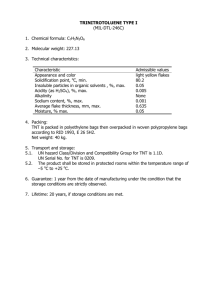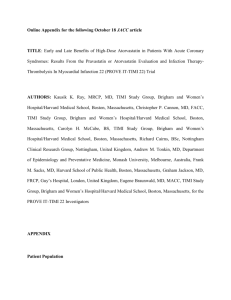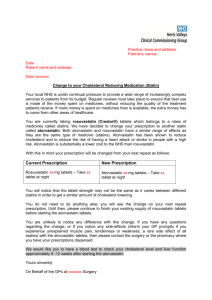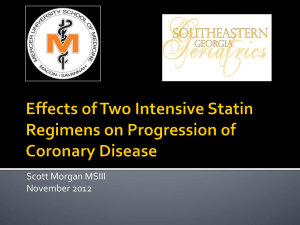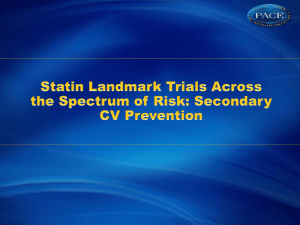Trial Overview - Clinical Trial Results
advertisement
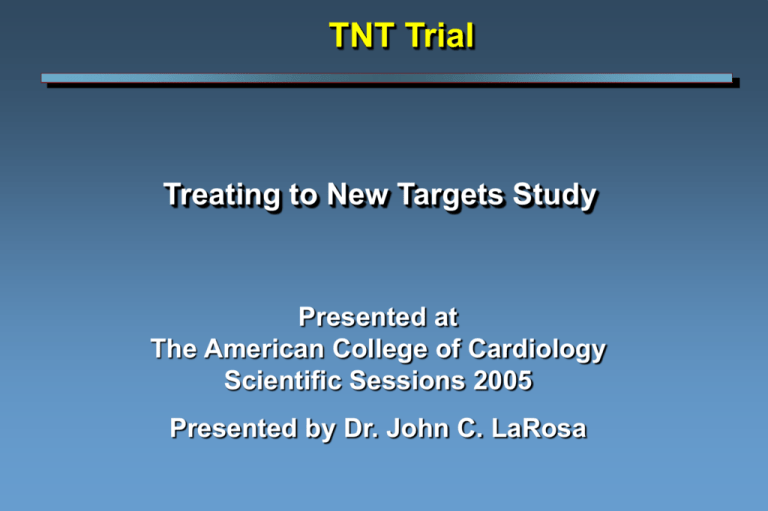
TNT Trial Treating to New Targets Study Presented at The American College of Cardiology Scientific Sessions 2005 Presented by Dr. John C. LaRosa TNT Trial 10,003 patients with stable coronary heart disease Age 35-75 years, LDL between 130 and 250 mg/dL, triglyceride ≤ 600 mg/dL 19% female, mean age 60.3 years All received atorvastatin 10 mg during 8 week open-label run-in period Atorvastatin 80 mg n=4,995 Atorvastatin 10 mg n=5,006 Primary Endpoint: Major cardiovascular event defined as coronary heart death (CHD) , nonfatal M, resuscitated cardiac arrest, and fatal or nonfatal stroke at a mean follow-up of 4.9 years. Secondary Endpoint: Major coronary events, cerebrovascular events, hospitalization for congestive heart failure (CHF), all-cause mortality, peripheral artery disease, any cardiovascular event, any coronary event www. Clinical trial results.org Presented at ACC 2005 TNT Trial: Primary endpoint Primary Composite of CHD death, nonfatal MI, resuscitated cardiac arrest, and fatal or nonfatal stroke 12% Hazard Ratio [HR]=0.78 p<0.001 10.9% 8.7% 8% • The primary composite endpoint of CHD death, nonfatal MI, resuscitated cardiac arrest, and fatal or nonfatal stroke was lower in the high-dose atorvastatin 80 mg group at a mean follow-up of 4.9 years. 4% 0% High-dose www. Clinical trial results.org Low-dose Presented at ACC 2005 TNT Trial: Primary Endpoint The individual components of the primary endpoint were also lower or tended to be lower in the high-dose group compared to the low-dose group with the exception of resuscitation after cardiac arrest, which was the equal in both groups. 8% p=0.004 6.2% 6% 4.9% p=0.02 4% p=0.09 2.0% 3.1% 2.5% 2.3% 2% p=0.89 0.5% 0.5% 0% CHD death Nonfatal MI High-dose www. Clinical trial results.org Resuscitation after cardiac arrest Stroke Low-Dose Presented at ACC 2005 TNT Trial: Secondary Endpoint •The components of the secondary endpoint that were lower in the high-dose group included: major coronary events, cerebrovascular events, and hospitalization for CHF. All-cause mortality and peripheral artery disease were equivalent in both high and low dose groups. Major Coronary Events p=0.002 9% 8.3% 6.7% Cerebrovascular Events p=0.007 All-cause Mortality Peripheral Artery Disease p=0.92 p=0.76 CHF 5.7% 6% 5.0% p=0.01 5.6% 5.5% 5.6% 3.9% 3.3% 3% 2.4% 0% High-dose www. Clinical trial results.org Low-Dose Presented at ACC 2005 TNT Trial Persistent elevations in liver aminotransferase levels, treatment-related adverse events, and study drug discontinuation due to adverse events were all higher in the high-dose group compared to the low-dose group. p<0.001 9% p<0.001 8.1% 7.2% 5.8% 6% 5.3% p<0.001 3% 1.2% 0.2% 0% Liver Aminotransferase High-dose www. Clinical trial results.org Adverse Events Drug discontinuation Low-Dose Presented at ACC 2005 TNT Trial: Summary • Among patients with stable coronary heart disease treatment with high-dose atorvastatin to achieve an LDL below 100 mg/dL was associated with a reduction in the primary composite endpoint of major cardiovascular events at 5 years compared with treatment with lowdose atorvastatin to achieve an LDL of approximately 100 mg/dL. • There was no difference in all-cause mortality in the high-dose compared to the low-dose group. • Persistent elevations in liver aminotransferase, treatment-related adverse events, and study drug discontinuation all occurred more frequently in the high-dose atorvastatin group compared to the lowdose group. There was no difference by treatment group in persistent CK elevations, myalgia, or rhabdomyolysis. www. Clinical trial results.org Presented at ACC 2005 TNT Trial: Summary cont’d • The overall safety profile was consistent with other large atorvastatin trials, and was likely relatively low due to the exclusion of the 131 patients with abnormal liver-function tests or myalgia during the run-in phase. Despite the exclusion of these patients, persistent with abnormal liver-function tests were more frequent with the 80 mg atorvastatin group, suggesting close monitoring is warranted in pateints treated with this dose. • In the PROVE-IT / TIMI 22 trial, aggressive lipid lowering with atorvastatin 80 mg was associated with a reduction in cardiovascular events compared with standard LDL lowering with pravastatin in patients with acute coronary syndrome. • The results from TNT confirm what was observed in PROVE-IT / TIMI 22 and suggest that aggressive lipid lowering to LDL levels <75 mg/dL reduces cardiovascular events in patients with stable coronary artery disease. www. Clinical trial results.org Presented at ACC 2005
